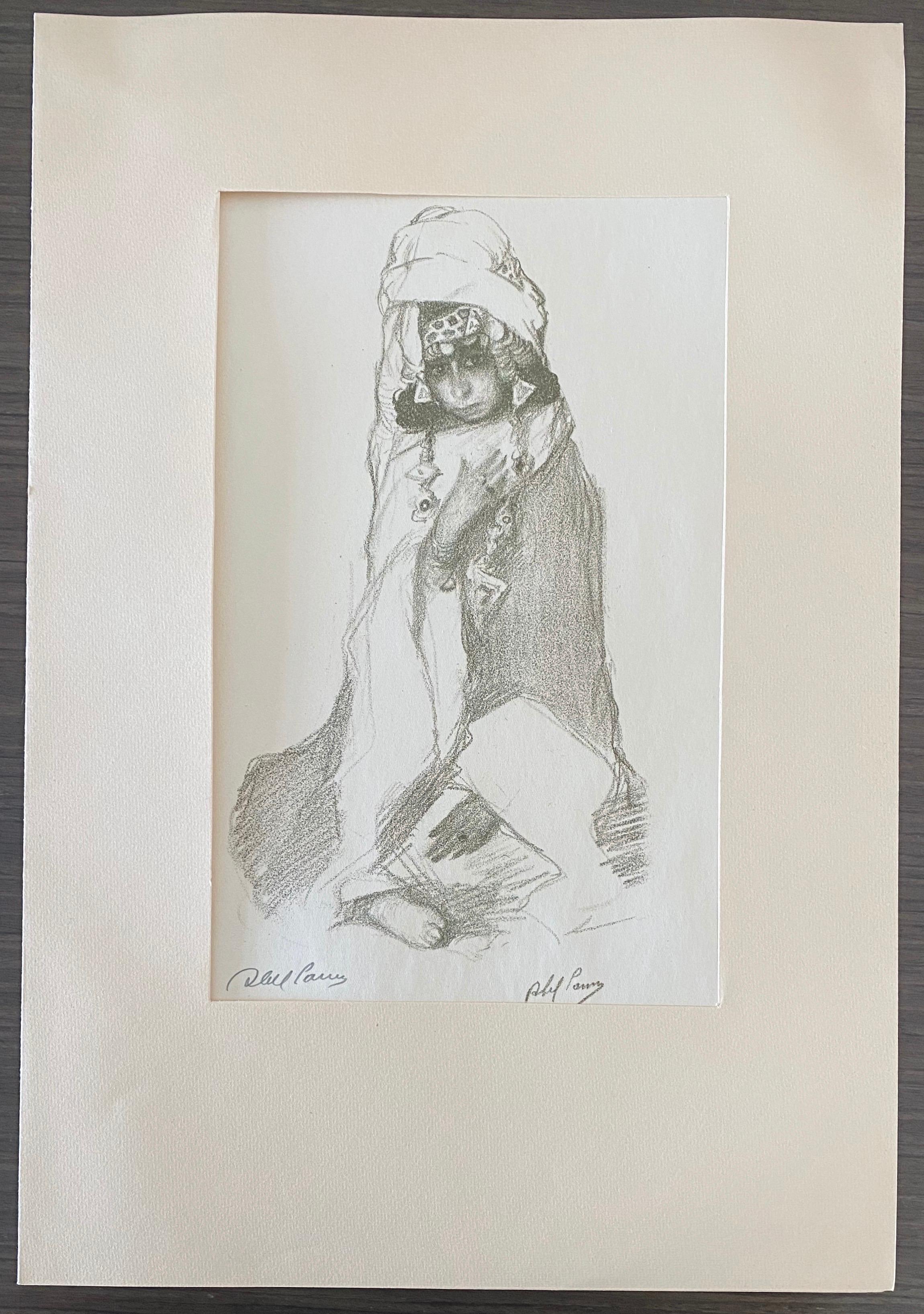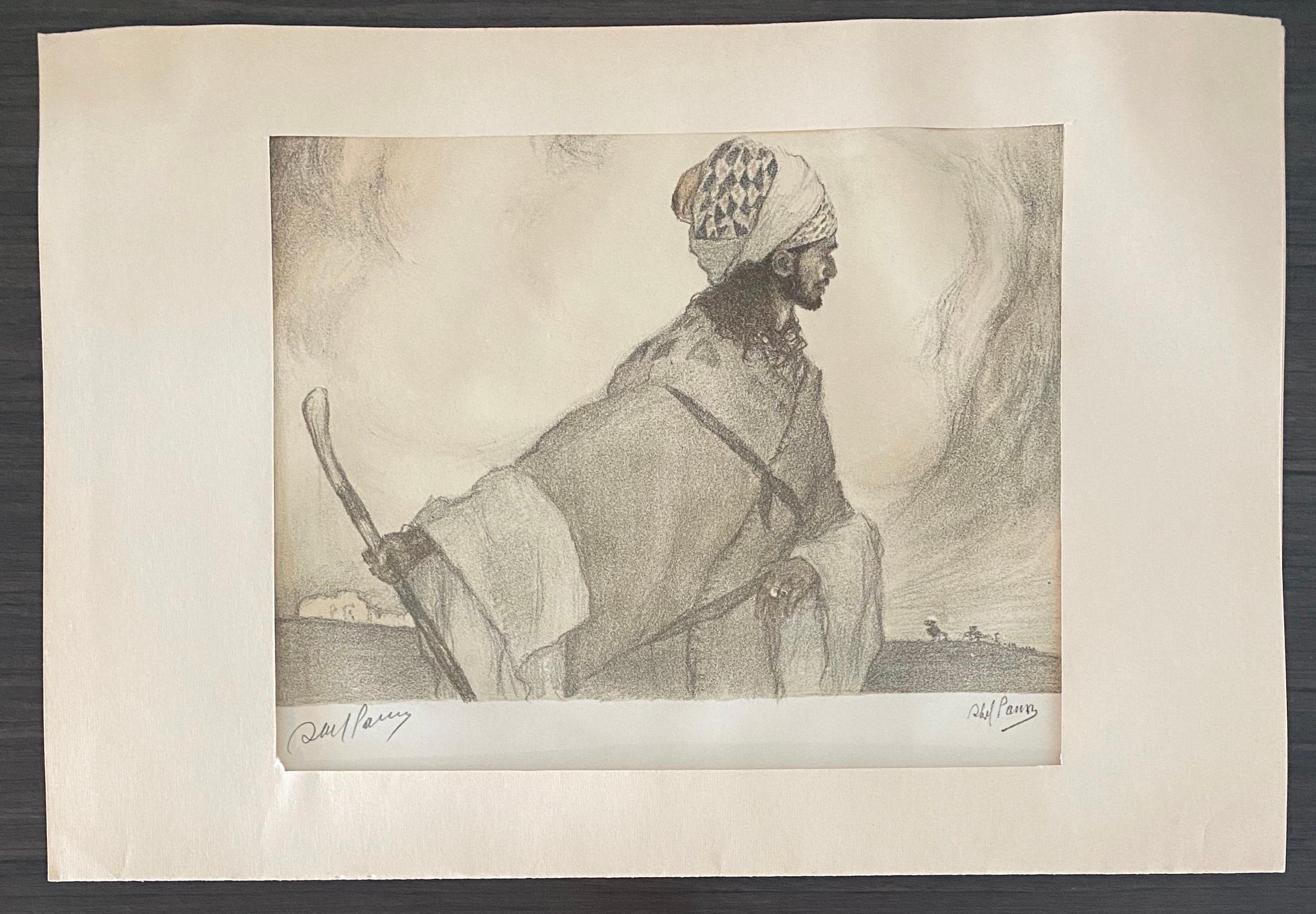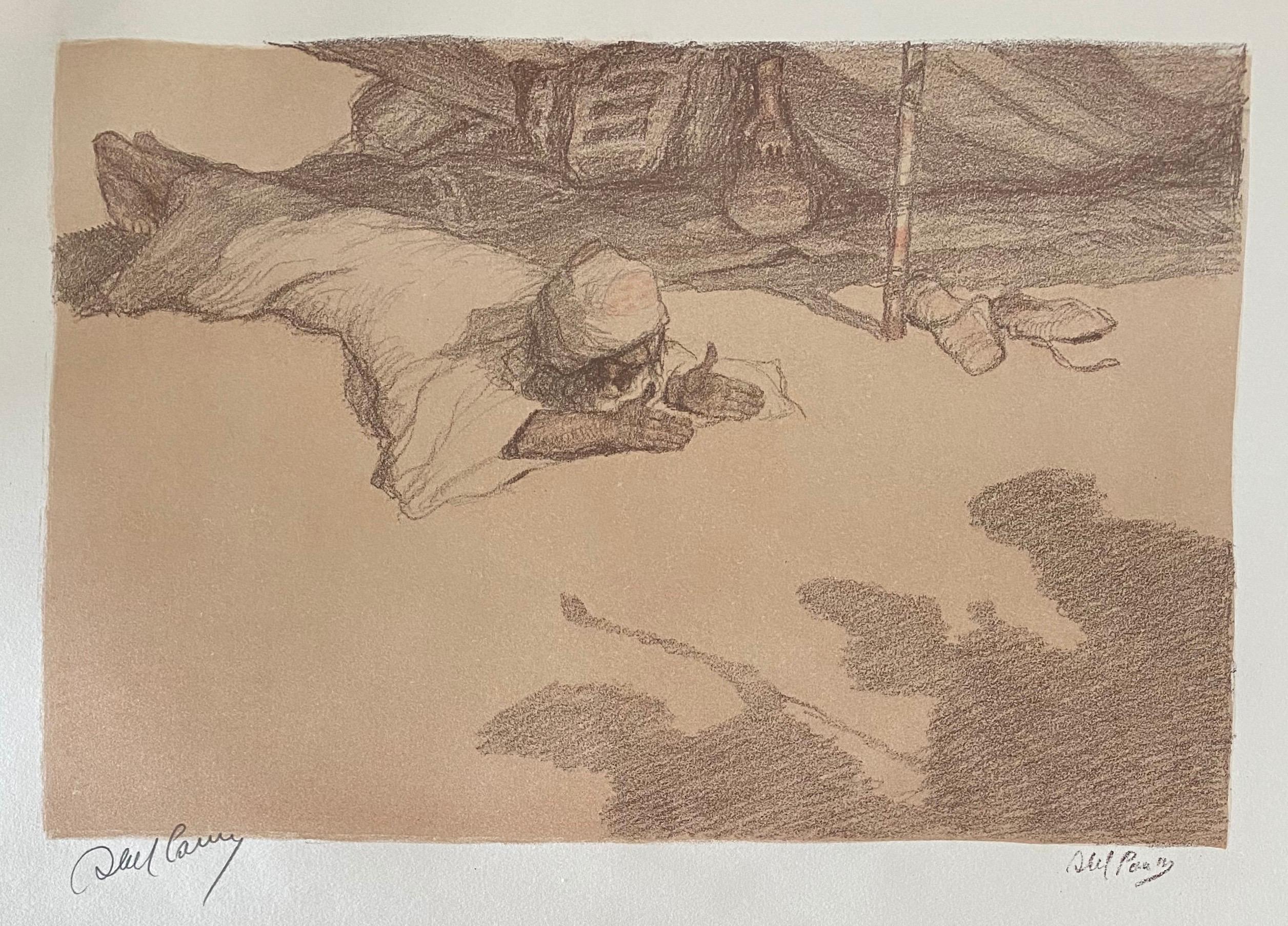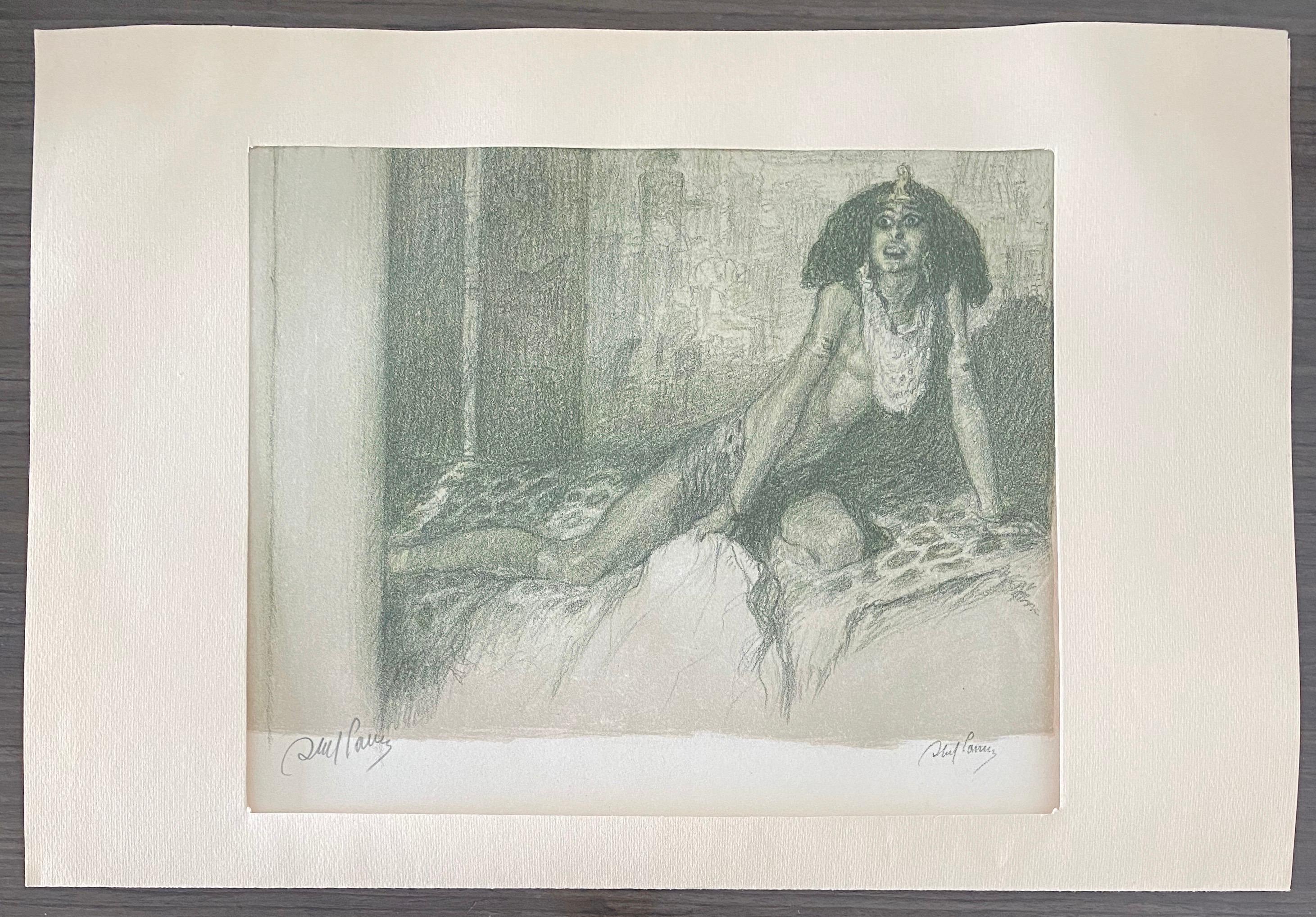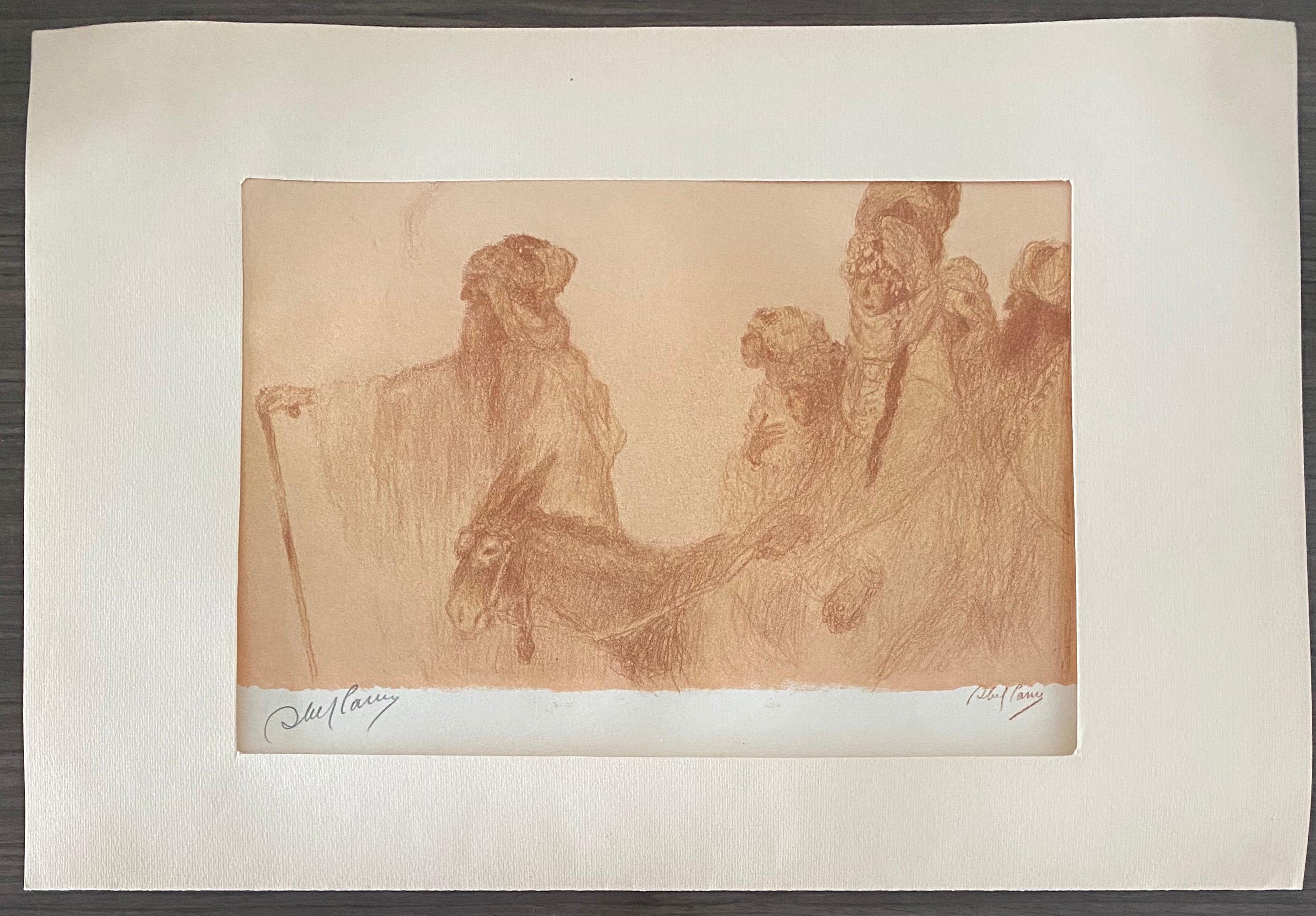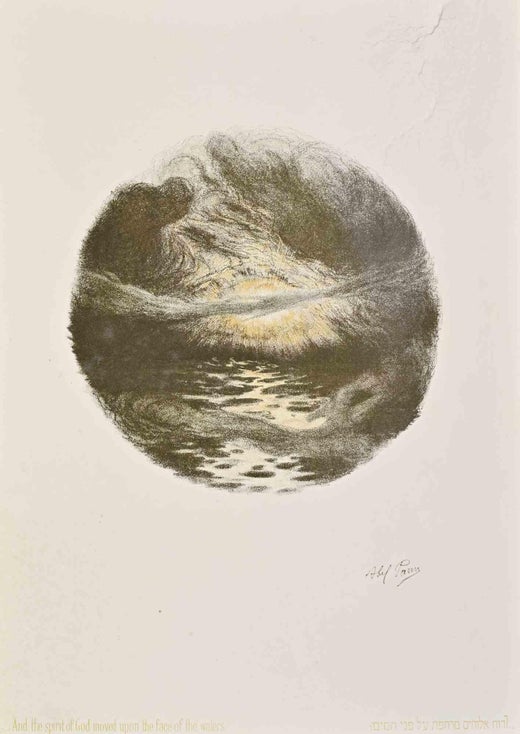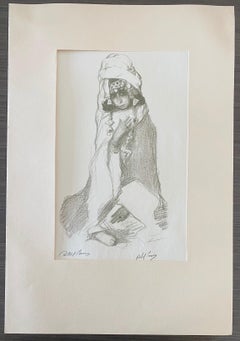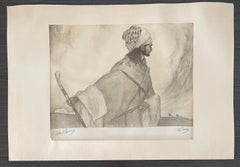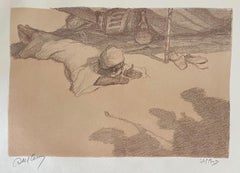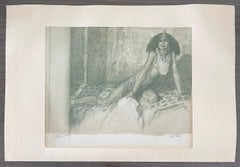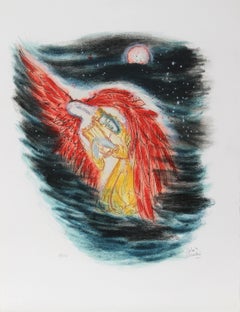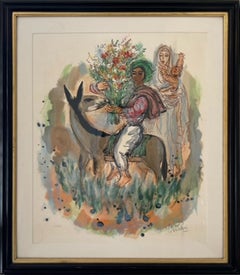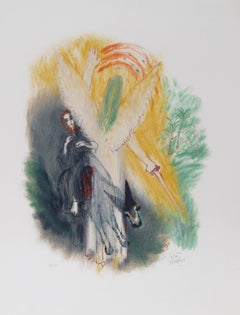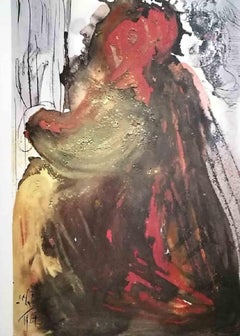Items Similar to Abel Pann Israeli Bezalel School Lithograph Judaica Biblical Print Jewish Art
Want more images or videos?
Request additional images or videos from the seller
1 of 11
Abel PannAbel Pann Israeli Bezalel School Lithograph Judaica Biblical Print Jewish Art
$800
£611.12
€702.12
CA$1,143.83
A$1,260.23
CHF 652.37
MX$15,173.52
NOK 8,260.61
SEK 7,760.32
DKK 5,242.64
About the Item
Abel Pann (1883–1963) was a European Jewish painter who settled in the Talpiot neighborhood of Jerusalem in the early twentieth century and taught at the Bezalel Academy of Art under Boris Schatz.
Abba Pfeffermann (later Abel Pann), born in Latvia or in Kreskowka, Vitebsk, Belarus, was a European Russian Jewish artist who immigrated to Ottoman Palestine and settled in Jerusalem. He was married to Esther Nussbaum. Pann's youngest son was killed in the 1947–1949 Palestine war. After that loss, he turned to painting scenes of the Holocaust. He died in Jerusalem in 1963.
Pann studied the fundamentals of drawing for three months with the painter Yehuda Pen of Vitebsk, who also taught Marc Chagall. In his youth, he traveled in Russia and Poland, earning a living mainly as an apprentice in sign workshops. In 1898 he went south to Odessa, where he was accepted into the Academy of Fine Arts. In 1903, he was in Kishinev, where he documented the Kishinev pogrom with drawings; an effort that is thought to have contributed to his self-definition as an artist who chronicles Jewish history. Still in 1903, he moved to Paris, where he rented rooms in La Ruche, a Parisian building (which still exists) where Modigliani, Chagall, Chaim Soutine and other Jewish artists also lived. Pann studied at the French Academy under William-Adolphe Bouguereau. He earned his living primarily by drawing pictures for the popular illustrated newspapers of the era. In 1912, Boris Schatz, founder and director of the Bezalel Academy of Arts and Design visited Pann in Paris and invited him to come work in Jerusalem.
In 1913, after traveling in Southern Europe and Egypt, Pann arrived in Jerusalem, where he had decided to settle for life. Pann went to see Schatz and it was decided that he would head the painting department at the Bezalel Academy for several months while Schatz embarked on an extensive overseas fund-raising trip. According to Haaretz art critic Smadar Sheffi, a work form this period with the simple title "Jerusalem" shows a cluster of buildings at sunset "with a sky in blazing orange." The painting is "more expressive and abstract that is typical of his work," and Sheffi speculates that "the encounter with the city" of Jerusalem was a "strong emotional experience" for the artist. Pann returned to Europe to arrange his affairs before moving permanently to the British Mandate of Palestine, but was caught on the continent by World War I. Pann's wartime paintings would prove to be among "the most important" of his career. He made many posters to support the French war effort. He also made a series of fifty drawings showing the extreme suffering of Jewish communities caught in the fighting between Germany, Poland and Russia. Art critic Smadar Sheffi regards them as "the most important part of his oeuvre." These "shocking" drawings put modern viewers in mind of depictions of the Holocaust. Pann's drawings were intended as journalistic documentation of the fighting and were successfully exhibited in the United States during the War. According to Pann's autobiography, the Russians, who were allied with the French, refused to allow a wartime exhibition of the drawings in France. According to The New York Times, the drawings were published in Paris during the war, but the government intervened to block their distribution on the grounds that they "reflected damagingly upon an ally" (Russia).
Upon his return to Jerusalem in 1920, Pann took up a teaching position at the Bezalel Academy and wrote that he was about to embark on his life-work, the painting and drawing of scenes from the Hebrew Bible. He returned briefly to Vienna, where he met and married Esther Nussbaum and purchased a lithographic press, which the couple brought home to Jerusalem. Pann began work on a series of lithographs intended to be published in an enormous illustrated Bible, and although that series was never completed, he is widely admired for the series of pastels inspired by Bible stories that he began in the 1940s. The iconography of these works is linked to the 19th century orientalism. He was part of a movement of contemporary Jewish artists interested in Biblical scenes, including Ephraim Moses Lilien, Reuven Rubin, Nachum Gutman, and Ze'ev Zeev Raban. Influenced by Art Nouveau and by the Symbolist movement. This influence can be seen in "You shall not surely die," a colored lithograph in which the serpent is represented as a bare-chested woman. The lithograph is reminiscent of the style of Aubrey Beardsley.
In 1924, Pann resigned from his teaching position to devote himself full-time to lithography. The lithographs met with considerable success on international tours.
Especially in his pastels, Pann envisioned Rachel, Rebekah, and other Biblical women as child-brides and imagined the teen-aged Jewish girls from Yemen whom he used as models along with young Bedouin girls, regarding both Yemenites and Bedouins as authentic oriental types. He posed them in elaborate traditional wedding and festival clothing and jewelry. In the twenties, the period when Pann was painting them, Yemenite and Bedouin girls did marry at the age of puberty. He often captured not only their youth and beauty, but the anxiety of a young girl about to marry a man she might hardly know. Other pastels capture the elderly matriarch Sarah looking "absolutely alive" and the care-worn facts of Jerusalem's Yemenite Jewish laborers, posed as Biblical patriarchs. Pann's work reveals an intimate familiarity with the work of Rembrandt, James Tissot, and other European painters of biblical scenes.
For many years, Pann was considered an important artist in Israel, and had even greater success among Jewish art consumers abroad, but he "outlived his artistic times," fading in importance beside the new, modernist painters. Although many of his paintings are in museum collections, private collectors can sometimes find them at galleries such as the Mayanot Gallery. In 1990 art curator and Israeli art historian, Shlomit Steinberg submitted an MA thesis at the History of Art department of the Hebrew University, Jerusalem, titled: "The Image of the Biblical Woman as Femme Fatale in Abel Pann's Works".
- Creator:Abel Pann (1883 - 1963, Russian)
- Dimensions:Height: 15.5 in (39.37 cm)Width: 11.5 in (29.21 cm)
- Medium:
- Movement & Style:
- Period:
- Condition:Minor edge wear, some creases and folded down the middle. Please see Photos.
- Gallery Location:Surfside, FL
- Reference Number:1stDibs: LU38215260712
Abel Pann
“Over many years, Abel Pann (1883-1963) was regarded as the foremost Land Of Israel Painter. This view was shared by the Jewish community throughout the world and by the general public in pre-State Israel where reproductions of his works were hung in almost every home”. This is how Yigal Zalmone, Chief Art Curator of the Israel Museum, describes Abel Pann. Abel Pann was born in 1883 in the town of Kreslawka in the Vitebsk region of White Russia. His father Nahum was a rabbi and head of a yeshiva, a religious academy. Pann received a Jewish elementary school education until he was twelve. He studied the fundamentals of drawing for three months with the painter Yehuda Pen of Vitebsk, who also taught Marc Chagall and Ossip Zadkine. When he was twelve he traveled between Russia and Poland, earning money as an apprentice in sign workshops. In 1898 he went south to Odessa, where he was accepted by the Academy of Fine Arts. In 1903 Pann moved to Paris, where his work included depictions of Jewish daily life, Parisian genre paintings, as well as sketches and caricatures that were humorous and psychological criticisms regarding society. His empathy for the poor and wretched became well known. In 1912, the director of the Bezalel School of Art and Crafts in Jerusalem asked Abel Pann to teach at the school which he accepted a year later. During the first year of World War I, Pann was restricted to leave Europe after he returned to recover belongings to take back to Jerusalem. During the first years of the war, he concentrated on popular, nationalist posters and illustrations, including depictions of the cruelty of the German enemy. In 1920 he returned to Jerusalem and resumed teaching at the Bezalel School, and formed the Palestine Art Publishing Company with which he used to print his albums of Bible illustrations. Abel Pann devoted much of his energy to these illustrations. An interesting approach that Pann used in these illustrations was to depict the Biblical subjects using contemporary clothing and imagery. Using contemporary Middle Eastern characters in Oriental dress within local settings fulfilled the Zionist dream that the Jewish people were going to return to their homeland and renew their days of old.
About the Seller
4.9
Platinum Seller
Premium sellers with a 4.7+ rating and 24-hour response times
Established in 1995
1stDibs seller since 2014
1,817 sales on 1stDibs
Typical response time: 1 hour
- ShippingRetrieving quote...Shipping from: Surfside, FL
- Return Policy
Authenticity Guarantee
In the unlikely event there’s an issue with an item’s authenticity, contact us within 1 year for a full refund. DetailsMoney-Back Guarantee
If your item is not as described, is damaged in transit, or does not arrive, contact us within 7 days for a full refund. Details24-Hour Cancellation
You have a 24-hour grace period in which to reconsider your purchase, with no questions asked.Vetted Professional Sellers
Our world-class sellers must adhere to strict standards for service and quality, maintaining the integrity of our listings.Price-Match Guarantee
If you find that a seller listed the same item for a lower price elsewhere, we’ll match it.Trusted Global Delivery
Our best-in-class carrier network provides specialized shipping options worldwide, including custom delivery.More From This Seller
View AllAbel Pann Israeli Bezalel School Lithograph Judaica Biblical Print Jewish Art
By Abel Pann
Located in Surfside, FL
Abel Pann (1883–1963) was a European Jewish painter who settled in the Talpiot neighborhood of Jerusalem in the early twentieth century and taught at the Bezalel Academy of Art under...
Category
Mid-20th Century Symbolist Figurative Prints
Materials
Lithograph
Abel Pann Israeli Bezalel School Lithograph Judaica Biblical Print Jewish Art
By Abel Pann
Located in Surfside, FL
Abel Pann (1883–1963) was a European Jewish painter who settled in the Talpiot neighborhood of Jerusalem in the early twentieth century and taught at the Bezalel Academy of Art under...
Category
Mid-20th Century Symbolist Figurative Prints
Materials
Lithograph
Abel Pann Israeli Bezalel School Lithograph Judaica Biblical Print Jewish Art
By Abel Pann
Located in Surfside, FL
Abel Pann (1883–1963) was a European Jewish painter who settled in the Talpiot neighborhood of Jerusalem in the early twentieth century and taught at the Bezalel Academy of Art under...
Category
Mid-20th Century Symbolist Figurative Prints
Materials
Lithograph
Abel Pann Israeli Bezalel School Lithograph Judaica Biblical Print Jewish Art
By Abel Pann
Located in Surfside, FL
Abel Pann (1883–1963) was a European Jewish painter who settled in the Talpiot neighborhood of Jerusalem in the early twentieth century and taught at the Bezalel Academy of Art under...
Category
Mid-20th Century Symbolist Figurative Prints
Materials
Lithograph
Abel Pann Israeli Bezalel School Lithograph Judaica Biblical Print Jewish Art
By Abel Pann
Located in Surfside, FL
Abel Pann (1883–1963) was a European Jewish painter who settled in the Talpiot neighborhood of Jerusalem in the early twentieth century and taught at the Bezalel Academy of Art under...
Category
Mid-20th Century Symbolist Figurative Prints
Materials
Lithograph
Abel Pann Israeli Bezalel School Lithograph Judaica Biblical Print Jewish Art
By Abel Pann
Located in Surfside, FL
Abel Pann (1883–1963) was a European Jewish painter who settled in the Talpiot neighborhood of Jerusalem in the early twentieth century and taught at the Bezalel Academy of Art under...
Category
Mid-20th Century Symbolist Figurative Prints
Materials
Lithograph
You May Also Like
VIII from Visions of the Bible, Modern Lithograph by Reuven Rubin
By Reuven Rubin
Located in Long Island City, NY
Reuven Rubin, Israeli (1893 - 1974) - VIII from Visions of the Bible, Year: 1972, Medium: Lithograph, signed and numbered in pencil, Edition: 83/150, Image Size: 25 x 18 inches, ...
Category
1970s Modern Figurative Prints
Materials
Lithograph
Untitled, Folk Art Lithograph by Reuven Rubin
By Reuven Rubin
Located in Long Island City, NY
This lithograph by Reuven Rubin features a captivating scene where a man gracefully rides atop a donkey, enveloped by a lush and vibrant garden filled with a profusion of colorful fl...
Category
2010s Figurative Prints
Materials
Lithograph
IX from Visions of the Bible, Modern Lithograph by Reuven Rubin
By Reuven Rubin
Located in Long Island City, NY
Reuven Rubin, Israeli (1893 - 1974) - IX from Visions of the Bible, Year: 1972, Medium: Lithograph, signed and numbered in pencil, Edition: 83/150, Image Size: 25 x 18 inches, Si...
Category
1970s Modern Figurative Prints
Materials
Lithograph
Planctus David in Mortem Saul - Lithograph - 1964
By Salvador Dalí
Located in Roma, IT
Planctus David in mortem Saul (" David's Mourning at the death of Saul ") is an artwork realized in 1964.
It is part of Biblia Sacra vulgatæ editionis published by Rizzoli-Mediola...
Category
1960s Surrealist Figurative Prints
Materials
Lithograph
Military - Original Etching by Anselmo Bucci - 1917s
By Anselmo Bucci
Located in Roma, IT
"Military" 1917s is a beautiful print in etching technique, realized by Anselmo Bucci (1887-1955).
Hand signed. Numbered 81/100 of prints on the lower left. On the lower left corner...
Category
1910s Modern Figurative Prints
Materials
Etching
X from Visions of the Bible, Modern Lithograph by Reuven Rubin
By Reuven Rubin
Located in Long Island City, NY
Reuven Rubin, Israeli (1893 - 1974) - X from Visions of the Bible, Year: 1972, Medium: Lithograph, signed and numbered in pencil, Edition: 83/150, Image Size: 25 x 18 inches, Siz...
Category
1970s Modern Figurative Prints
Materials
Lithograph
More Ways To Browse
Picasso Acrobat
Picasso Boy
Picasso La Danse
Picasso Minotaur Print
Picasso Mother And Child
Picasso Pierrot
Picasso Prints Limited Editions
Picasso Stamped Signature
Picasso The Couple
Pietro Fontana Etching
Rabbi German
Raoul Dufy Signed Lithograph
Rie Munoz Prints
River Phoenix
Romare Bearden Mother And Child
Rudolf Hausner
Rufino Tamayo Mixografia
Salvador Dali 1976
